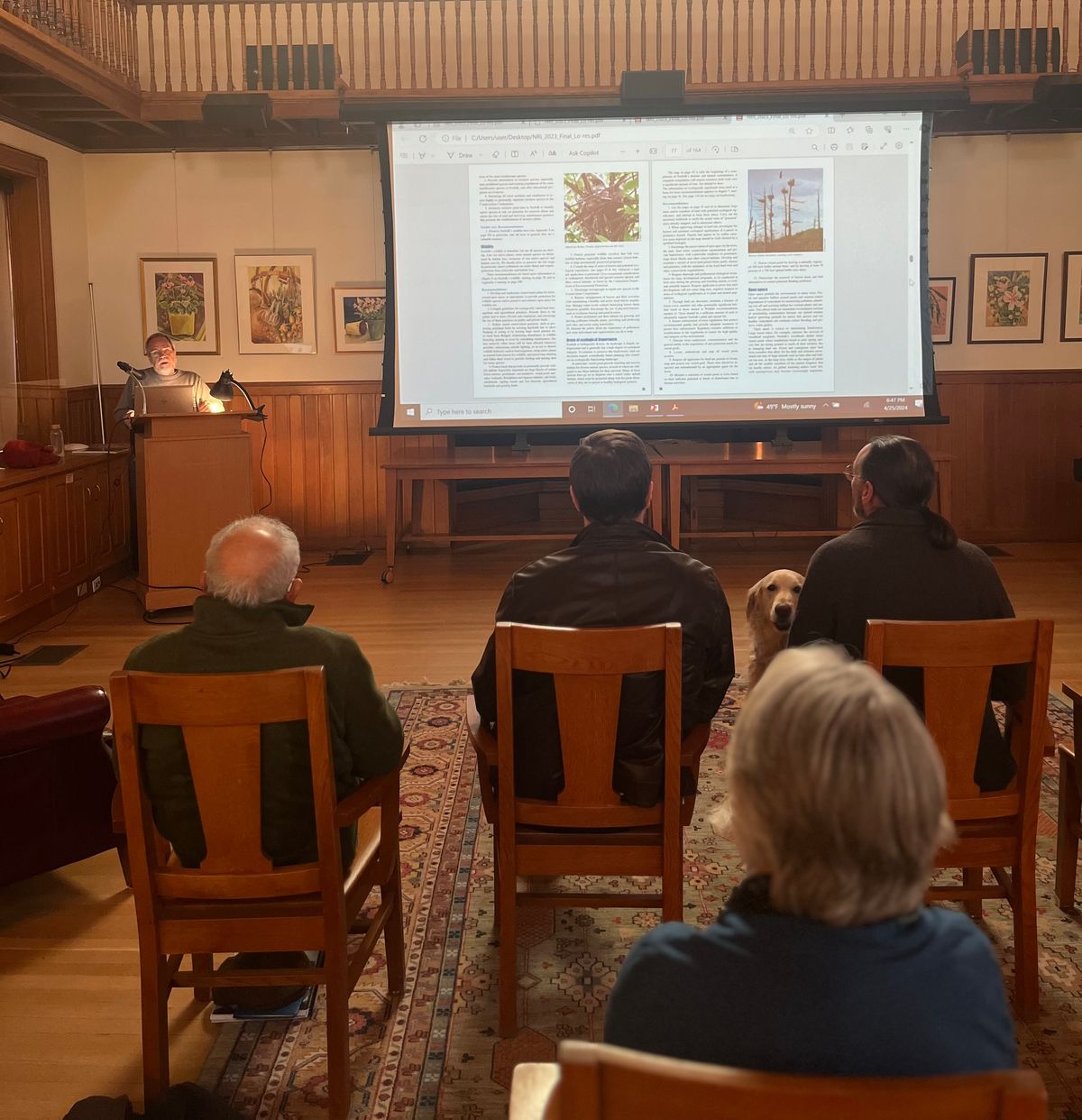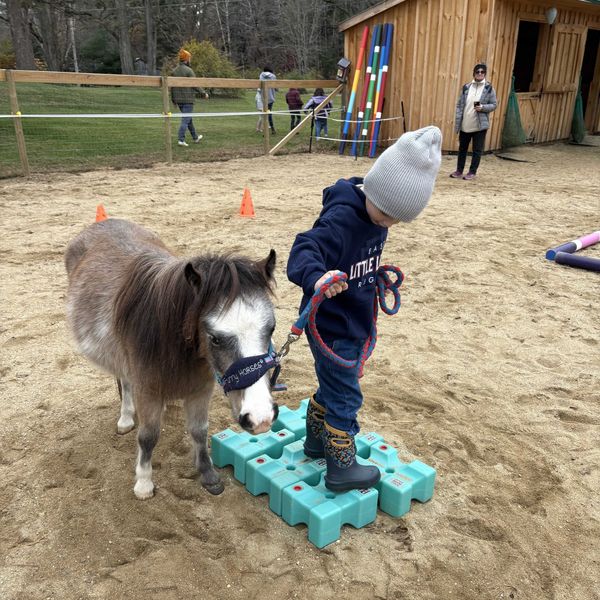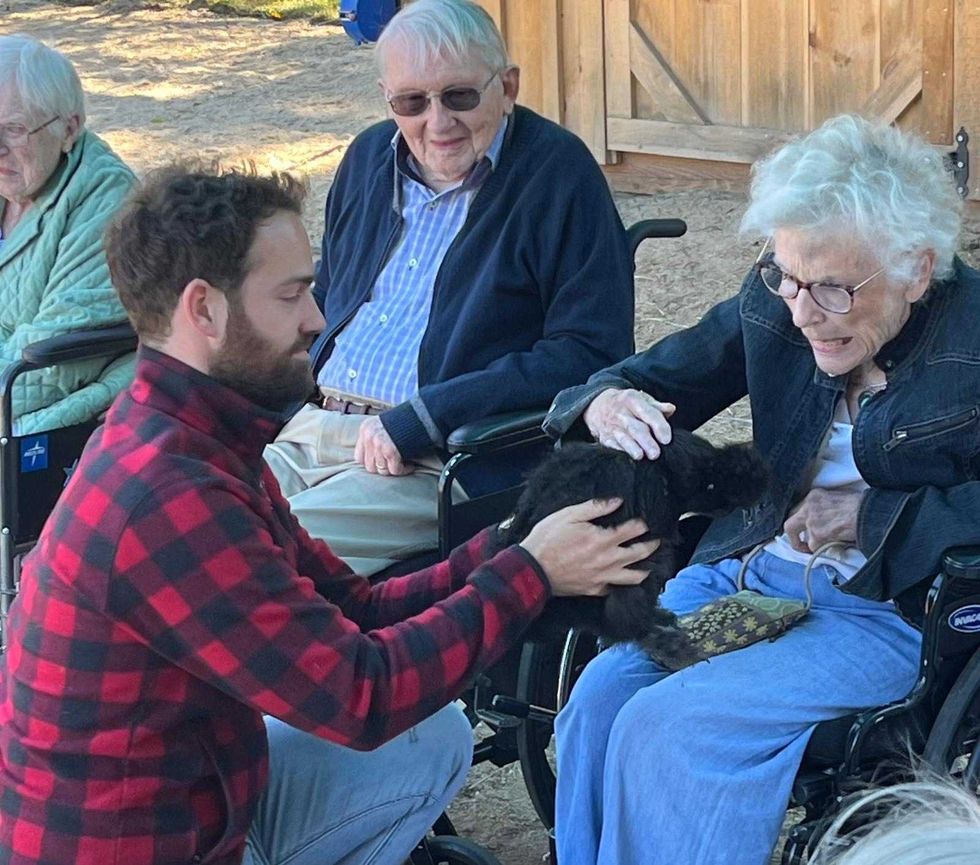Reviewing Norfolk’s natural resources

A small audience, including a very friendly golden retriever, reviewed Norfolk's natural resource inventory April 25.
Mike Cobb

A small audience, including a very friendly golden retriever, reviewed Norfolk's natural resource inventory April 25.
NORFOLK — On Thursday, April 25 at 5:30 p.m., The Norfolk Conservation Commission held its natural resource inventory discussion at the Norfolk Library to a small audience, including a very friendly golden retriever.
Appointed by the Board of Selectmen, the Norfolk Conservation Commission keeps an index of all open publicly or privately owned areas to obtain information on their proper use; conducts research into the use, and possible use, of land in Norfolk; administers gifts, and approves state grants for the use of open space land for conservation or recreation purpose.
Led by John Anderson, the discussion provided updates to the 2023 Natural Resource Inventory, outlined the chapters, including the “recommendations” section, and answered questions from the public.
When Anderson presented information on Norfolk’s wetlands, library director Ann Havemeyer asked, “what defines a bog?”
“It’s a highly acidic body of water with particular plants and animals that live there. For example, Sphagnum moss floats on top of water which allows plants to grow on top of that. Beckley Bog is a prime example in Norfolk,” Anderson answered.
He further described different types of wetlands in Norfolk and how they interact.
“Holleran swamp is attached to Wood Creek Pond, which extends into a swampy area. There’s enough soil that trees like Spruce and Fir can grow there.”
While viewing images of a beaver pond on the big screen, an audience member asked how beavers affect the landscape.
“Beavers make dams because they don’t like to spend a lot of time out of the water, though they will harvest wood from shrubs and trees. They’re trying to create more water for their food supply of aquatic plants,” Anderson said.
Anderson rated Norfolk’s groundwater as very good because of the filtering effect of heavy forest cover. However, the November 2022 Gas spill and the use of salt to defrost roads are concerning.
“We’re testing salinity in local freshwater supplies. We’ll test and decide what to do, for example to use less salt and alternatives,” he said.
Anderson also described how water is connected in Norfolk.
“Norfolk participated in a region wide study of how streams are connected. There’s a database evaluating stream road crossing and how it might affect wildlife. Recent storms have been more intense than in years past. Many culverts and bridges are not built for this. Climate change certainly plays a role,” he said.
Anderson moved swiftly through the massive amount of information and covered plantscape, with a focus on the trees and wildflowers of Norfolk including pictures of northern species that aren’t typically found elsewhere in Connecticut.
The inventory focused on large rather than old trees. “Great Mountain Forest had the largest red spruce in the state, but it was struck by lightning and died. It’s been made into the mantle at the Curling Club,” Anderson said.
Regarding wildlife, he said, “Norfolk is unusual in many ways. We have a really good bear, bobcat, and moose population and a lot of species that have been extricated and are now here such as wild turkeys and fisher cats. The bird population is strong with a few new species including Sand Hill cranes. Thanks to our forests we have Rough grouse. We’ve added sections on butterflies and moths with an extensive appendices of 650 species of moths.”
“We’re cold, northern and deserve the name of the Icebox. We have really good clean wetlands and forests,” he added.
Anderson also described how The Norfolk Land Trust and the historic work of private individuals such as Ted Childs have helped preserve large areas of land. The report contains maps showing the intersection of private and public protected land including trails for recreational activities.
Other topics included the importance of rural roads, dark night skies, the use of proper lighting, the effect of lighting in some animals’ ability to forage food, historic buildings and roads, and more. The appendix section provides detailed tables on all aspects of the inventory. Each section has a bibliography with information about the contributors.
“We’re fortunate to have had so many people do so much good work. It is exceptional,” Anderson said.
The report also made recommendations, such as education on climate change and ways the public can get involved. “We’re going to do a sale of native plants. There’s a movement to encourage more of that and grow plants that are natural to the area,” Anderson added.
“Once Upon a Time in America” features ten portraits by artist Katro Storm.
The Kearcher-Monsell Gallery at Housatonic Valley Regional High School in Falls Village is once again host to a wonderful student-curated exhibition. “Once Upon a Time in America,” ten portraits by New Haven artist Katro Storm, opened on Nov. 20 and will run through the end of the year.
“This is our first show of the year,” said senior student Alex Wilbur, the current head intern who oversees the student-run gallery. “I inherited the position last year from Elinor Wolgemuth. It’s been really amazing to take charge and see this through.”
Part of what became a capstone project for Wolgemuth, she left behind a comprehensive guide to help future student interns manage the gallery effectively. “Everything from who we should contact, the steps to take for everything, our donors,” Wilbur said. “It’s really extensive and it’s been a huge help.”
Art teacher Lilly Rand Barnett first met Storm a few years ago through his ICEHOUSE Project Space exhibition in Sharon, “Will It Grow in Sharon?” in which he planted cotton and tobacco as part of an exploration of ancestral heritage.
“And the plants did grow,” said Barnett. She asked Storm if her students could use them, and the resulting work became a project for that year’s Troutbeck Symposium, the annual student-led event in Amenia that uncovers little-known or under-told histories of marginalized communities, particularly BIPOC histories.
Last spring, Rand emailed to ask if Storm would consider a solo show at HVRHS. He agreed.
And just a few weeks ago, he arrived — paints, brushes and canvases in tow.
“When Katro came to start hanging everything, he took up a mini art residency in Ms. Rand’s room,” Wilbur said. “All her students were able to see his process and talk to him. It was great working with him.”
Perhaps more unexpected was his openness. “He really trusted us as curators and visionaries,” Wilbur said. “He said, ‘Do with it what you will.’”

Storm’s artistic training began at New Haven’s Educational Center for the Arts. His talent earned him a full scholarship to the Arts Institute of Boston, then Boston’s Museum School, where he painted seven oversized portraits of influential Black figures — in seven days — for his final project. Those works became the backbone of his early exhibitions, including at Howard University’s National Council for the Arts.
Storm has created several community murals like the 2009 READ Mural featuring local heroes, and several literacy and wellness murals at the Stetson Branch Library in New Haven. Today, he teaches and works, he said, “wherever I set up shop. Sometimes I go outside. Sometimes I’m on top of roofs. Wherever it is, I get the job done.”
His deep ties to education made a high school gallery an especially meaningful stop. “No one really knew who these people were except maybe John Lennon,” Storm said of the portraits in the show. “It’s really important for them to know James Baldwin and Shirley Chisholm. And now they do.”
The exhibition includes a wide list of subjects: James Baldwin, Shirley Chisholm, Redd Foxx, Jasper Johns, Marilyn Manson, William F. Buckley, Harold Hunter, John Lennon, as well as two deeply personal works — a portrait of Tracy Sherrod (“She’s a friend of mine… She had an interesting hairdo”) and a tribute to his late friend Nes Rivera. “Most of the time I choose my subjects because there are things I want to see,” Storm said.
Storm’s paintings, which he describes as “full frontal figuratism,” rely on drips, tonal shifts, and what feels like emerging depth. His process moves quickly. “It depends on how fast it needs to get done,” he said. “Sometimes I like to take the long way up the mountain. Instead of doing an outline, I just start coloring, blocking things off with light and dark until it starts to take shape.”
He’s currently in a black-and-white phase. “Right now, I’m inspired by black and white, the way I can really get contrast and depth.”
Work happens on multiple canvases at once. “Sometimes I’ll have five paintings going on at one time because I go through different moods, and then there’s the way the light hits,” he said. “It’s kind of like cooking. You’ve got a couple things going at once, a couple things cooking, and you just try to reach that deadline.”
For Wilbur, who has studied studio arts “ever since I was really young” and recently applied early decision to Vassar, the experience has been transformative. For Storm — an artist who built an early career painting seven portraits in seven days and has turned New York’s subway corridors into a makeshift museum — it has been another chance to merge artmaking with education, and to pass a torch to a new generation of curators.
Le Petit Ranch offers animal-assisted therapy and learning programs for children and seniors in Sheffield.
Le Petit Ranch, a nonprofit offering animal-assisted therapy and learning programs, opened in April at 147 Bears Den Road in Sheffield. Founded by Marjorie Borreda, the center provides programs for children, families and seniors using miniature horses, rescued greyhounds, guinea pigs and chickens.
Borreda, who moved to Sheffield with her husband, Mitch Moulton, and their two children to be closer to his family, has transformed her longtime love of animals into her career. She completed certifications in animal-assisted therapy and coaching in 2023, along with coursework in psychiatry, psychology, literacy and veterinary skills.
Le Petit Ranch operates out of two small structures next to the family’s home: a one-room schoolhouse for animal-assisted learning sessions and a compact stable for the three miniature horses, Mini Mac, Rocket and Miso. Other partner animals include two rescued Spanish greyhounds, Yayi and Ronya; four guinea pigs and a flock of chickens.
Borreda offers programs at the Scoville Library in Salisbury, at Salisbury Central School and surrounding towns to support those who benefit from non-traditional learning environments.
“Animal-assisted education partners with animals to support learning in math, reading, writing, language and physical education,” she said. One activity, equimotricité, has children lead miniature horses through obstacle courses to build autonomy, confidence and motor skills.

She also brings her greyhounds into schools for a “min vet clinic,” a workshop that turns lessons on dog biology and measuring skills into hands-on, movement-based learning. A separate dog-bite prevention workshop teaches children how to read canine body language and respond calmly.
Parents and teachers report strong results. More than 90% of parents observed greater empathy, reduced anxiety, increased self-confidence and improved communication and cooperation in their children, and every parent said animal-assisted education made school more enjoyable — with many calling it “the highlight of their week.”

Le Petit Ranch also serves seniors, including nursing home residents experiencing depression, social withdrawal or reduced physical activity. Weekly small-group sessions with animals can stimulate cognitive function and improve motor skills, balance and mobility.
Families can visit Le Petit Ranch for animal- assisted afterschool sessions, Frech immersion or family walks. She also offers programs for schools, libraries, community centers, churches, senior centers and nursing homes.
For more information, email info@lepetitranch.com, visit lepetitranch.com, follow @le.petit.ranch on Instagram or call 413-200-8081.